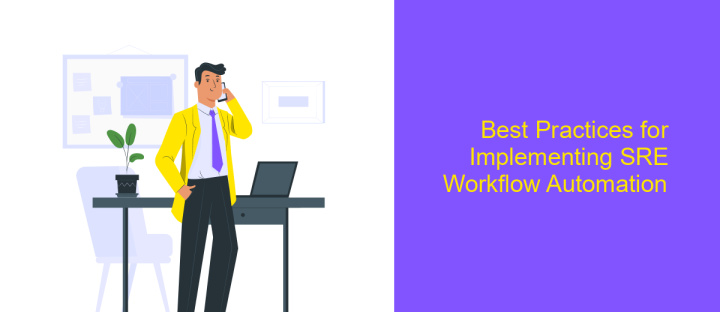SRE Workflow Automation
Site Reliability Engineering (SRE) Workflow Automation is revolutionizing the way organizations manage their IT infrastructure. By automating routine tasks and incident responses, SRE teams can focus on higher-value activities, improve system reliability, and reduce human error. This article explores the key components, benefits, and best practices of implementing SRE workflow automation to enhance operational efficiency and resilience.
Introduction
Site Reliability Engineering (SRE) has emerged as a pivotal practice in ensuring the reliability and efficiency of systems. Automation plays a crucial role in this domain, streamlining workflows and reducing manual intervention. Implementing automated processes not only enhances operational efficiency but also minimizes the risk of human error.
- Automated monitoring and alerting
- Continuous integration and deployment (CI/CD)
- Automated incident response
- Integration with third-party services
One of the key aspects of SRE workflow automation is integrating various tools and services seamlessly. Platforms like ApiX-Drive facilitate these integrations, enabling teams to connect different applications and automate data flows effortlessly. By leveraging such services, organizations can achieve a higher level of automation, ensuring that their systems are both resilient and scalable.
Benefits of SRE Workflow Automation

SRE Workflow Automation significantly enhances the efficiency and reliability of system operations by automating repetitive and time-consuming tasks. This allows Site Reliability Engineers (SREs) to focus on more strategic and complex issues, thus improving overall system performance and reducing the risk of human error. Automation tools can streamline incident response, monitoring, and deployment processes, ensuring faster resolution times and more consistent outcomes. By minimizing manual interventions, organizations can achieve higher uptime and better service quality.
Moreover, integrating various services and tools becomes seamless with platforms like ApiX-Drive, which facilitates the automation of workflows across multiple applications. ApiX-Drive enables easy setup of integrations without requiring extensive coding knowledge, allowing SREs to quickly connect different systems and automate data flows. This not only saves time but also ensures that critical information is synchronized and readily available across platforms. As a result, SREs can maintain a more resilient and responsive infrastructure, ultimately leading to improved customer satisfaction and business continuity.
Types of SRE Workflow Automation

SRE workflow automation plays a crucial role in enhancing the efficiency and reliability of system operations. By automating repetitive and time-consuming tasks, SRE teams can focus on more strategic initiatives and reduce the risk of human error.
- Incident Response Automation: Automating the detection and resolution of incidents can significantly reduce downtime. Tools like PagerDuty can automatically alert the right personnel and even initiate predefined remediation steps.
- Infrastructure as Code (IaC): Using IaC tools such as Terraform or Ansible allows SRE teams to automate the provisioning and management of infrastructure. This ensures consistency and reduces the likelihood of configuration drift.
- Monitoring and Alerting: Automated monitoring systems, like Prometheus, continuously check the health of systems and trigger alerts when anomalies are detected. This helps in proactive issue detection and resolution.
- Integration Automation: Services like ApiX-Drive facilitate seamless integration between various tools and platforms, enabling automated workflows and data synchronization. This reduces manual intervention and enhances operational efficiency.
By leveraging these types of automation, SRE teams can maintain higher levels of system reliability and performance. Automation not only speeds up processes but also ensures that best practices are consistently followed, leading to more robust and resilient systems.
Best Practices for Implementing SRE Workflow Automation

Implementing SRE workflow automation requires careful planning and execution to ensure efficiency and reliability. One of the key practices is to start small and gradually scale up. This approach allows for manageable iterations and easier identification of potential issues.
Another critical practice is to prioritize tasks that offer the highest impact with the least effort. By focusing on high-value, low-effort tasks, teams can quickly demonstrate the benefits of automation and gain stakeholder support.
- Utilize reliable integration services like ApiX-Drive to streamline data flow between various tools and platforms.
- Implement robust monitoring and alerting systems to promptly detect and address any automation failures.
- Regularly review and update automated workflows to adapt to changing requirements and technologies.
- Ensure comprehensive documentation and training for team members to maximize the effectiveness of automation efforts.
Finally, fostering a culture of continuous improvement and collaboration is essential. Encourage team members to share insights and feedback, enabling the constant refinement of automated workflows. This collaborative approach not only enhances efficiency but also drives innovation within the SRE team.


Conclusion
The implementation of SRE Workflow Automation has proven to be a game-changer in maintaining system reliability and efficiency. By automating repetitive tasks, SRE teams can focus on more strategic initiatives, thus enhancing overall productivity. Moreover, automation helps in minimizing human errors, ensuring consistent and reliable system performance. This shift not only improves operational efficiency but also enables quicker response times to incidents, thereby reducing downtime and enhancing user satisfaction.
Integrating various tools and services is crucial for effective SRE Workflow Automation. Solutions like ApiX-Drive facilitate seamless integration, allowing different systems to communicate effortlessly. This integration capability ensures that data flows smoothly across platforms, enabling real-time monitoring and quicker decision-making. By leveraging such services, organizations can create a more cohesive and responsive SRE environment, ultimately leading to more robust and resilient systems. As we continue to advance in automation, the role of integrative platforms will become increasingly significant in driving efficiency and reliability in SRE practices.
FAQ
What is SRE Workflow Automation?
How can I get started with SRE Workflow Automation?
What are the benefits of using SRE Workflow Automation?
Can I integrate different systems and tools in my SRE workflow?
Is it necessary to have coding skills to implement SRE Workflow Automation?
Apix-Drive is a simple and efficient system connector that will help you automate routine tasks and optimize business processes. You can save time and money, direct these resources to more important purposes. Test ApiX-Drive and make sure that this tool will relieve your employees and after 5 minutes of settings your business will start working faster.

